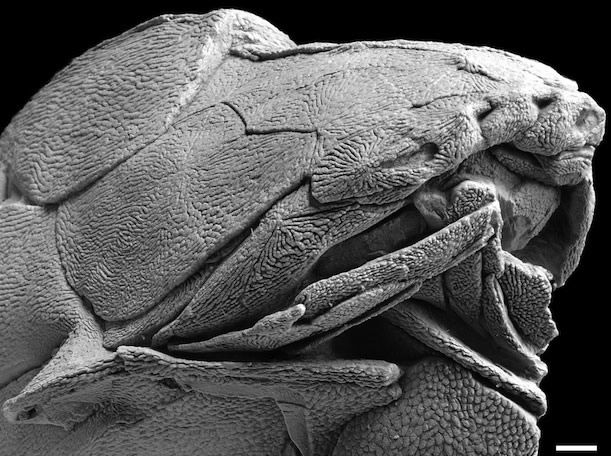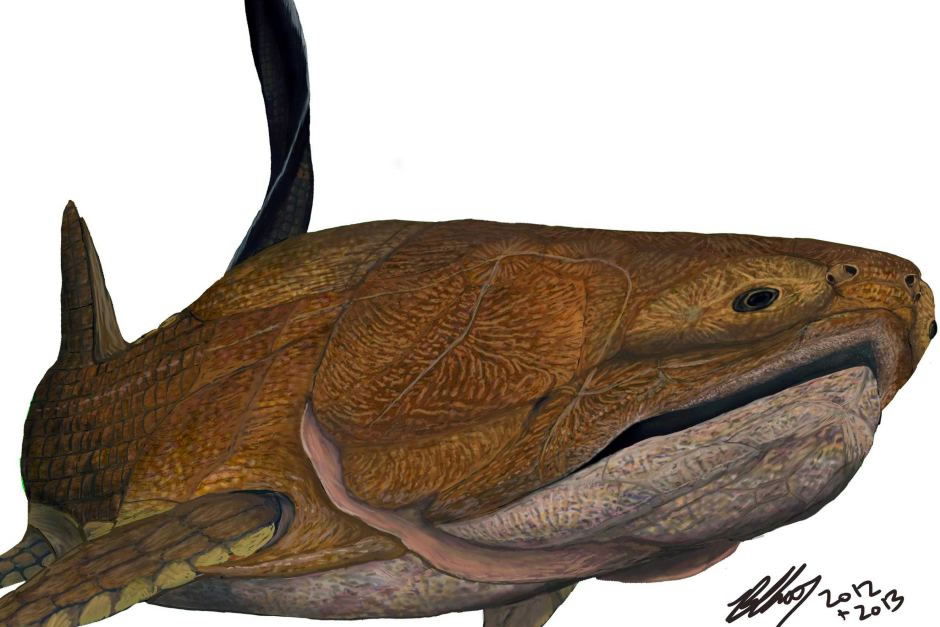
Missing Link Found? Fossil Fish Face Flips Humanity’s “Evolutionary History” on Its Head
Abstract
Jaws of life get an evolutionary face-lift from “a bony-fish-like grin.”1
News Source
Most vertebrates have jaws. Evolutionists have long traced the ancestry of modern-jawed vertebrates—including people—back to bony fish and their presumed evolutionary ancestor, a shark-like precursor. New research from China published September 25 in Nature presents “a 419-million-year-old fossil and accompanying analysis that turn this view on its head”2 and “puts a new face on the original jawed vertebrate.”3
The fish that has evolutionists speculating that “this ancient strange-looking face belongs to one of your oldest ancestors”4 shares characteristics of two presumably unrelated groups of fish—bony fish and placoderms. Evolutionists consider bony fish to be the ancestors of birds, amphibians, reptiles, and mammals. But placoderms, an extinct armored fish, have long been considered unrelated to bony fish. Placoderms, Nature reports, “had a bony skull and jaw, but most of them had simple beak-like jaws built out of bone plates.”5 Entelognathus primordialis, however, had a lower jawbone and two upper jawbones just like modern bony fish.
Min Zhu of the Chinese Academy of Sciences, lead author of the study, says, “It has a jaw similar to the modern fish, so we can see intermediary between Placoderms and modern fish or modern vertebrae.”

Was this the face that launched vertebrate evolution? This fossilized fish from Silurian rock in China, conventionally dated at about 419 million years, has evolutionists scrambling to re-write the origins of bony jawed vertebrates. The fish, shown here with its jaw jutting to the right, nostrils visible just above the mouth, and a small eye socket (above the mouth and to the left of the nostrils), has characteristics of extinct armored fish called placoderms. However, the bony plates around its jaw are characteristic of bony fish, to which evolutionists traditionally have considered placoderms unrelated. The discovery has upset evolutionary tradition that considered cartilaginous shark-like fish to be the ancestors of all bony fish and ultimately of all birds, amphibians, reptiles, and mammals. Image by Nature/Min Zhu et al., via Smithsonian.6 (Scale bar=1 cm)
Tradition Toppling?
Nature writers Matt Friedman of Oxford and Martin Brazeau of Imperial College London explain that the traditional evolutionary shark-like precursor hypothesis was based on the assumption that “the anatomical peculiarities of bony fishes—the group that would eventually give rise to ourselves—are specializations that arose later in vertebrate evolutionary history.”7
“The exciting thing about this fossil is that when you look at the top of it, it looks like a placoderm, but when you look at the side of the fish and the structure of the jaw, it doesn't look like any placoderm that we know of,” says evolutionary paleobiologist Friedman. “This tends to suggest the exciting possibility that these jawbones evolved way deep down in the lineage, so these features we used to hold as being unique to bony fishes may not be so unique.”8
“Basically, as terrestrial vertebrates,” Friedman says, “we are a kind of very specialized, very bizarre fish that about 370 million years ago went on land and lost its fins. Understanding the origin of bony fishes is inextricably linked to understanding our own origins because we're bony fishes. These different bones in our skull, the ones that medical students learn the names of, where and when in our family tree did they arrive? It suggests a real antiquity to some of the most prominent features of our own bony faces.”9

This is an artist’s reconstruction of a fish some scientists now think has the oldest bony jaw in the world. Entelognathus primordialis is being considered a “missing link” because it has characteristics commonly attributed to bony fish and to placoderms. Evolutionists have traditionally considered placoderms and bony fish unrelated. Image by AFP: Brian Choo/Chinese Academy of Sciences, via ABC News.10
“Entelognathus primordialis is one of the earliest, and certainly the most primitive, fossil fish that has the same jawbones as modern bony fishes and land vertebrates including ourselves,” Zhu says. “The human jaw is quite directly connected to the jaw of this fish, and that's what makes it so interesting.”11
“The unknown question was where did modern fish fauna come from, who was their ancestor?” says Professor John Long of Flinders University, Adelaide, Australia, commenting on the study for the Australian Broadcasting Corporation News. “This ancient fish called Entelognathus is the missing link because it shows that the extinct armoured Placoderms fishes, which dominated the seas, rivers and lakes of the world for 70 million years, actually were the ancestors to all the living fish on the planet today.”
Placoderms are traditionally thought to have branched off the tree of life before the divergence of cartilaginous fish and bony fish. Evolutionists also believe that cartilaginous and bony fish diverged from a common ancestor, not that one evolved from the other. Nevertheless, sharks are traditionally thought of as more primitive, so evolutionists have assumed that the ancient common ancestral jaw developed from a shark-like one.12
Zhu and colleagues report that Entelognathus primordialis, however, shares anatomical features with both osteichthyans (bony fish) and placoderms. Thus, from the evolutionary point of view, the shark-like ancestor is booted from its position as the template for all the subsequent jaws-of-life.
Entelognathus primordialis, found in Silurian rock conventionally dated 443 to 419 million years, at first appeared to be an ordinary placoderm. But on closer inspection it seemed to be missing the simple jawbones (gnathal plates) associated with placoderms. Instead, its jaws, throat, and gills were protected by articulating bony plates reminiscent of those found only on bony fish.
“Both in the overall pattern and the specific detail of these plates, the fossil showcases traits that were once considered diagnostic of bony fishes, and entirely unknown in placoderms,”13 Friedman and Brazeau explain. “Entelognathus, it seems, is a placoderm with a bony-fish-like grin.”14
Evolutionists must conclude from this “piscine mash-up”15 that either the bony grin of Entelognathus was ancestral to similar structures in bony fish or bony jaws independently evolved twice. The evolutionary interpretation of the discovery puts bony vertebrates in the primitive ancestral seat and forces cartilaginous fish into a more “advanced” spot.
Embryologically and developmentally, many bones in vertebrates form first as cartilaginous templates and add the bony material later. Falling back on the presumed principles of embryonic recapitulation, many evolutionists, assuming embryonic development is a replay of evolutionary development, have presumed that a cartilaginous skeleton is a more evolutionarily primitive condition, with bony fish evolving later. From an evolutionary point of view, this study turns that belief upside down.
“How did we get it so wrong?”
“This inversion of a classic scenario in vertebrate evolution raises an obvious question,” Friedman and Brazeau ask. “How did we get it so wrong?”16 Deriding the oversimplified “popular model of a shark-like ancestor,”17 they conclude:
Added to this conceptual inertia is a historically compartmentalized approach to studying early vertebrate groups that made it too easy to dismiss shared similarities—the head and shoulder exoskeleton of placoderms and bony fishes, for example—as independent innovations without adequate evidence. [emphasis ours]
Perhaps more than any of these discoveries, Entelognathus demands a major rethink of where fossils fit relative to modern lineages, and how these living groups came to acquire their characteristic traits. It will take time to fully digest the implications of such a remarkable fossil, but it is clear that a major reframing of our understanding of early gnathostome [jawed vertebrate] evolution is now in full swing.18
We would offer a different answer to “how did we get it so wrong?”
The phylogenetic tree constructed by evolutionists has indeed been built “without adequate evidence” on a foundation of unverifiable assumptions (such as atheistic beliefs, for instance) about the past. The origin of life, its increasing complexity, and its divergence into various lineages are scientifically unobservable, imaginary events. No doubt those who accept evolutionary just-so-stories believe them whole-heartedly, and many—particularly “theistic evolutionists” who compromise biblical truth by blending a tiny portion of it with molecules-to-man evolution—fail to realize evolutionary stories represent an effort to explain life without God.
So what do we make of this interesting fossilized fish? It is just another kind of extinct fish.
Biological science, however, has never observed the emergence of life from non-living matter through random processes. Neither has biological science ever observed organisms evolving into new kinds of increasingly complex organisms. Living organisms produce variety within the original created kinds, certainly, but they do not evolve into more complex kinds. Thus actual biological observation does not conflict with the biblical record of Genesis, where the Creator reports to us that He created all kinds of plants and animals to reproduce “after their kinds.” Furthermore, God, in Exodus 20:11, reminded Moses and the Hebrew people—and hence all of us—that He created all things in just six days.
So what do we make of this interesting fossilized fish? It is just another kind of extinct fish, a descendant of fish similar to itself created about 6,000 years ago on the 5th day of Creation week. Birds did not evolve from bony fish but were created on the same day. Likewise, all kinds of land animals and the first two humans were created on the very next day, without evolving from anything.
Many organisms that are now extinct are preserved in the fossil record, most having been buried there in association with the global Flood of Noah’s day by the catastrophic upheavals of the earth’s surface. This fish is an example of the biodiversity God created, but its discovery does not prove that the evolution of bony vertebrates happened in a reverse order from that previously assumed because bony vertebrates did not evolve at all.
Further Reading
- Vestigial Hiccups, Folding Fish-eyes, and Other Fables: Our Fishy Forebears . . . Again!
- Developments in Fish Said to Show How Limbs Evolved
- Where Are All the Bunny Fossils?
- How Manatees Lost Their Legs?
- The Origin of Vertebrates
- Tiktaalik and the Fishy Story of Walking Fish
- Tiktaalik and the Fishy Story of Walking Fish, Part 2
- Recapitulation Theory: Repackaged & Re-Applied
For More Information: Get Answers
Remember, if you see a news story that might merit some attention, let us know about it! (Note: if the story originates from the Associated Press, FOX News, MSNBC, the New York Times, or another major national media outlet, we will most likely have already heard about it.) And thanks to all of our readers who have submitted great news tips to us. If you didn’t catch all the latest News to Know, why not take a look to see what you’ve missed?
(Please note that links will take you directly to the source. Answers in Genesis is not responsible for content on the websites to which we refer. For more information, please see our Privacy Policy.)
Footnotes
- M. Friedman and M. Brazeau, “A Jaw-Dropping Fossil Fish,” Nature, September 25, 2013, doi:10.1038/nature12690.
- Ibid.
- Ibid.
- Joseph Stromberg, “This 419-Million-Year-Old Fish Has the World’s Oldest Known Face,” Smithsonian, September 25, 2013, http://www.smithsonianmag.com/science-nature/this-419-million-year-old-fish-has-the-worlds-oldest-known-face-88409/?no-ist=.
- Scott Neuman, “Ancient Fish With Strong Jawline Could Rewrite History Of Faces,” NPR, September 25, 2013, http://www.npr.org/sections/thetwo-way/2013/09/25/226143474/ancient-fish-with-strong-jawline-could-rewrite-history-of-faces.
- Stromberg, “This 419-Million-Year-Old Fish Has the World’s Oldest Known Face.”
- Friedman and Brazeau, “A Jaw-Dropping Fossil Fish.”
- Brian Handwerk, “Fish Fossil Has Oldest Known Face, May Influence Evolution,” National Geographic, September 26, 2013, http://news.nationalgeographic.com/news/2013/09/130925-fish-fossil-paleontology-science-evolution-face/.
- Ibid.
- Tom Nightingale, “419-Million-Year-Old Armoured Fish Fossil Resolves ‘Missing Link’ in Evolution, Scientists Say,” ABC News, September 25, 2013, http://www.abc.net.au/news/2013-09-26/fossil-discovery-links-gap-in-evolutionary-knowledge-of-fish/4981652.
- Ibid.
- Friedman and Brazeau, “A Jaw-Dropping Fossil Fish.”
- Ibid.
- Ibid.
- Ibid.
- Ibid.
- Ibid.
- Ibid.
Recommended Resources

Answers in Genesis is an apologetics ministry, dedicated to helping Christians defend their faith and proclaim the good news of Jesus Christ.
- Customer Service 800.778.3390
- © 2024 Answers in Genesis






